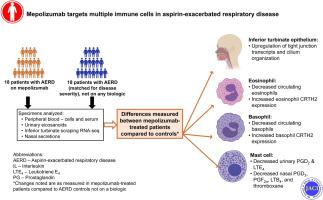Journal of Allergy and Clinical Immunology ( IF 14.2 ) Pub Date : 2021-06-16 , DOI: 10.1016/j.jaci.2021.05.043 Kathleen M Buchheit 1 , Erin Lewis 2 , Deborah Gakpo 2 , Jonathan Hacker 2 , Aaqib Sohail 1 , Faith Taliaferro 3 , Evans Berreondo Giron 4 , Chelsea Asare 4 , Marko Vukovic 5 , Jillian C Bensko 2 , Daniel F Dwyer 1 , Alex K Shalek 6 , Jose Ordovas-Montanes 7 , Tanya M Laidlaw 1

|
Background
Eosinophilic asthma and nasal polyposis are hallmarks of aspirin-exacerbated respiratory disease (AERD), and IL-5 inhibition has been shown to provide therapeutic benefit. However, IL-5Rα is expressed on many cells in addition to eosinophils, and the mechanisms by which IL-5 inhibition leads to clinical benefit in eosinophilic asthma and nasal polyposis are unlikely to be due exclusively to antieosinophil effects.
Objective
We sought to identify the mechanisms by which anti–IL-5 treatment with mepolizumab improves respiratory inflammation in AERD.
Methods
The clinical characteristics, circulating granulocytes, nasal scraping transcripts, eosinophilic cationic protein, tryptase, and antibody levels, and urinary and nasal eicosanoid levels were measured for 18 subjects with AERD who were taking mepolizumab and compared with those of 18 matched subjects with AERD who were not taking mepolizumab.
Results
Subjects taking mepolizumab had significantly fewer peripheral blood eosinophils and basophils, and those cells that remained had higher surface CRTH2 expression than did the cells from subjects not taking mepolizumab. Nasal prostaglandin F2α, prostaglandin D2 metabolites, leukotriene B4, and thromboxane levels were lower in subjects taking mepolizumab, as were urinary levels of tetranor–prostaglandin D2 and leukotriene E4. The nasal epithelial cell transcripts that were overexpressed among subjects with AERD who were taking mepolizumab were enriched for genes involved in tight junction formation and cilium organization. Nasal and urinary prostaglandin E2, tryptase, and antibody levels were not different between the 2 groups.
Conclusion
IL-5 inhibition in AERD decreases production of inflammatory eicosanoids and upregulates tight junction–associated nasal epithelial cell transcripts, likely due to decreased IL-5 signaling on tissue mast cells, eosinophils, and epithelial cells. These direct effects on multiple relevant immune cells contribute to the mechanism of benefit afforded by mepolizumab.
中文翻译:

美泊利单抗靶向治疗阿司匹林加重的呼吸道疾病中的多种免疫细胞
背景
嗜酸性粒细胞性哮喘和鼻息肉病是阿司匹林加重性呼吸系统疾病 (AERD) 的标志,IL-5 抑制已显示可提供治疗益处。然而,除了嗜酸性粒细胞外,IL-5Rα 还在许多细胞上表达,并且 IL-5 抑制导致嗜酸性粒细胞性哮喘和鼻息肉病临床获益的机制不太可能完全归因于抗嗜酸性粒细胞作用。
客观的
我们试图确定美泊利单抗抗 IL-5 治疗改善 AERD 呼吸道炎症的机制。
方法
测量了 18 名服用美泊利单抗的 AERD 受试者的临床特征、循环粒细胞、鼻腔刮擦转录物、嗜酸性阳离子蛋白、类胰蛋白酶和抗体水平,以及尿液和鼻腔类花生酸水平,并与 18 名服用美泊利单抗的 AERD 受试者进行比较不服用美泊利单抗。
结果
服用美泊利单抗的受试者外周血嗜酸性粒细胞和嗜碱性粒细胞显着减少,而那些保留下来的细胞表面 CRTH2 表达高于未服用美泊利单抗受试者的细胞。鼻前列腺素 F 2α、前列腺素 D 2代谢物、白三烯 B 4和血栓素水平在服用美泊利单抗的受试者中较低,四去甲前列腺素 D 2和白三烯 E 4的尿液水平也较低。在服用美泊利单抗的 AERD 受试者中过度表达的鼻上皮细胞转录本富含参与紧密连接形成和纤毛组织的基因。鼻和尿前列腺素 E 2、类胰蛋白酶和抗体水平在两组之间没有差异。
结论
AERD 中的 IL-5 抑制可减少炎性类花生酸的产生并上调紧密连接相关的鼻上皮细胞转录物,这可能是由于组织肥大细胞、嗜酸性粒细胞和上皮细胞上的 IL-5 信号减少所致。这些对多种相关免疫细胞的直接影响有助于美泊利单抗提供的获益机制。



























 京公网安备 11010802027423号
京公网安备 11010802027423号